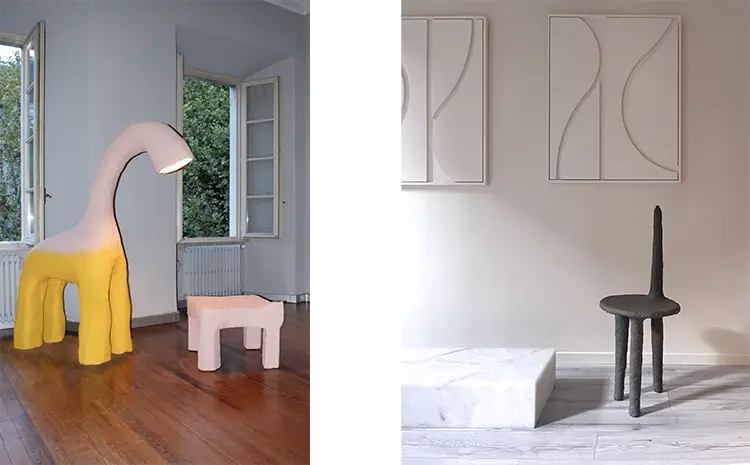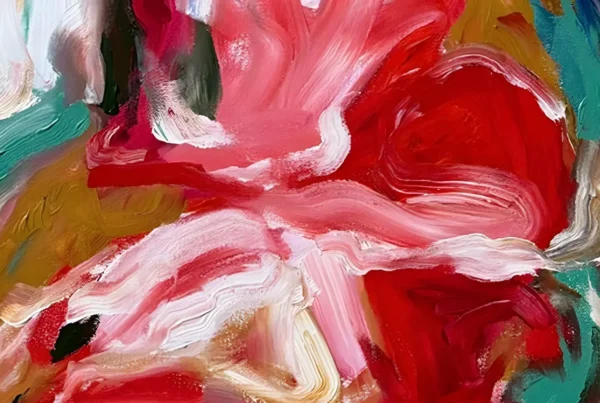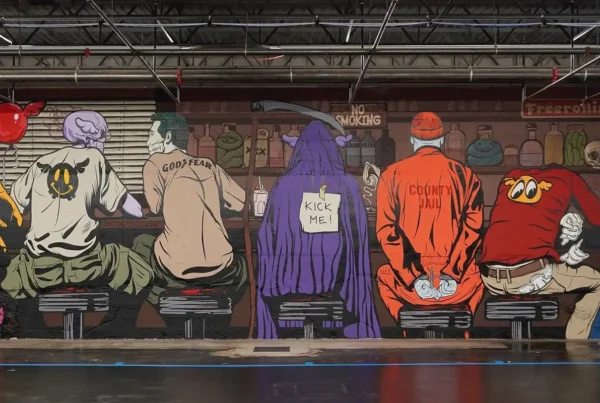“Creative projects today should be conceived and made using waste materials.”
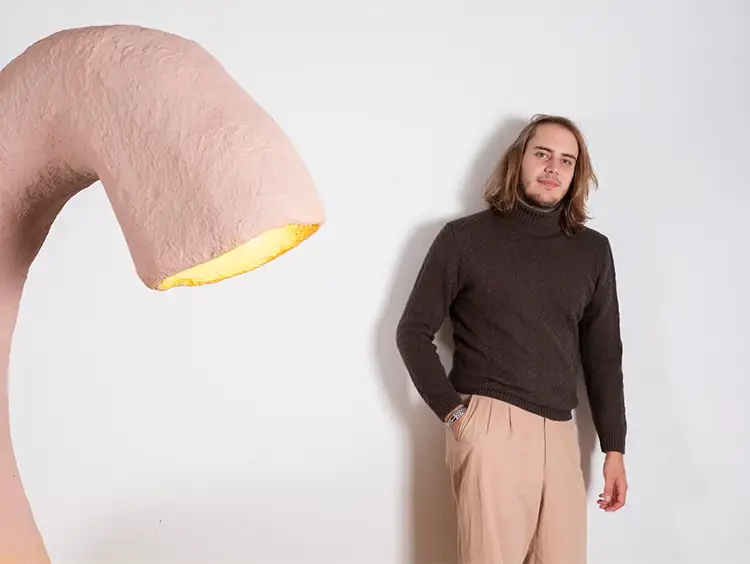
Tradition as Rebellion: The Roots Beneath the Sculpture
Emerging from the quiet yet culturally rich province of Lucca in Tuscany, Jonathan Bocca has transformed his local heritage into a global design language. Trained in design at Liceo Artistico in Lucca and later at IED Florence, with a formative stint at UAL Chelsea College of Arts in London, Bocca’s academic trajectory traces a deliberate path through spaces steeped in both history and innovation. However, it was not academia that ignited his passion—it was necessity. Struggling with dyslexia, drawing became an instinctive outlet, shaping his understanding of visual language as a form of self-assertion. His career officially took root during an exhibition by Cartasia, where he salvaged remnants of other artists’ paper to construct his first collection, Unsettling Objects, a foundational gesture that revealed his enduring interest in transformation and reuse.
At the core of Bocca’s practice is a material intimately tied to his hometown: recycled industrial paper. Lucca, one of Europe’s foremost paper-exporting centers, offered not only an abundance of discarded material but also a symbolic foundation for his ethos. Collecting factory waste, he developed a proprietary formula to create a clay-like paper pulp—durable, organic, and astonishingly malleable. This medium does more than serve function; it embodies a critique of overproduction and a commitment to sustainability. His techniques are deeply influenced by the Viareggio Carnival’s float-making traditions, where enormous papier-mâché structures parade through coastal streets each February. Bocca’s sculptural work inherits this blend of spectacle and craftsmanship, blurring the lines between fine art, functional design, and local cultural ritual.
This connection to place is not nostalgic; it’s radical. Through his sculptural pieces, Bocca aims to resurrect a vanishing artisanal culture—a counterpoint to the flattening sameness of globalized design. For him, Italian cities have lost their individuality, sacrificed to the gods of mass production and commercial uniformity. His work insists on reintroducing emotion, narrative, and locality into the everyday objects that populate our lives. Rather than chase sleek minimalism or luxury for its own sake, he searches for the emotional resonance in things—those quiet, strange qualities that transform them from tools into companions.
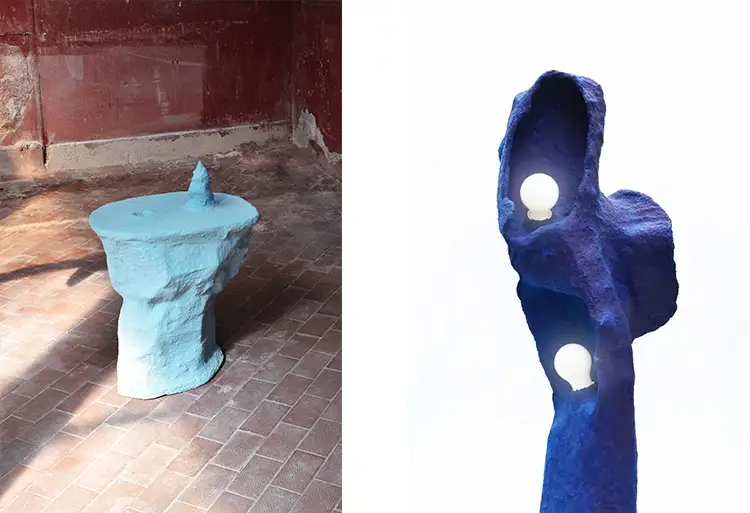
Jonathan Bocca: The Emotion Inside the Object
Bocca’s creations do not merely sit within a space—they communicate. He envisions each piece not just as an object but as a creature, capable of forming emotional connections with those who encounter it. This concept is rooted in a deep philosophical concern with emotional intelligence, which he sees as alarmingly absent in contemporary society. Drawing on thinkers like Umberto Galimberti, Bocca considers emotional expression to be an antidote to intellectual stagnation. Without it, he believes, we become disconnected from the inner dimensions that make life meaningful. His artworks, whether lamps or chairs, are designed as “pills of emotion,” compact interventions aimed at rekindling wonder and awareness in daily life.
The physical construction of his sculptures is not divorced from these emotional ambitions. Each component—often sourced from waste—is imbued with intention. Bocca rejects the notion of luxury as display, critiquing its current role as an empty signifier. He proposes instead a redefinition of value grounded in purpose and sustainability. For him, a gold-plated faucet pouring polluted water is not luxurious—it’s absurd. Referencing the design ethos of Bruno Munari, he advocates for an approach where one creation leads thoughtfully to another, guided not by trend or price but by integrity and care. In this philosophy, beauty and function must emerge from intelligent use of available resources, not the exploitation of precious ones.
This approach finds vivid expression in several signature works. Bicefalo, a dual-headed lamp, symbolizes the tension between reason and emotion—a material metaphor for internal dialogue. Sirena, a light sculpture drawing on the myth of sirens, explores the seductive danger of perception, using three light sources to create an eerie, dreamlike effect. Meanwhile, Zampa—a chair designed during the aftermath of the pandemic—embodies resilience and latent energy. With legs that appear poised to move, it evokes a restless vitality, an object that refuses to remain static. In each piece, the sculptural form becomes a vessel for psychological and emotional inquiry.
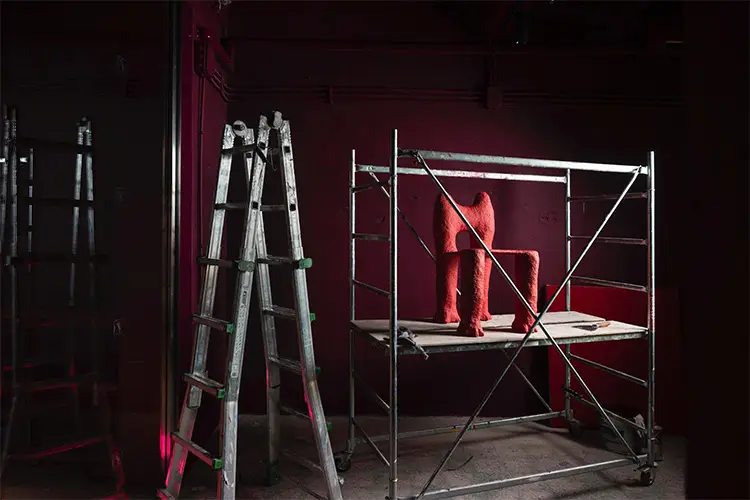
Function as Story: Narratives in Reclaimed Materials
Bocca’s design philosophy operates at the intersection of narrative and sustainability. Every item he produces is more than a utilitarian object—it is a carrier of memory, cultural identity, and ecological consciousness. His ongoing series Tradition II exemplifies this ambition. Created using local paper, marble, and polystyrene, the pieces in this collection—including a lamp and a table—reflect the artisanal history of Lucca while simultaneously proposing a futuristic vision for design. These are not mere furnishings; they are intimate beings constructed to form emotional bonds with their users. Each material is chosen not for prestige but for story—an embodiment of where it’s from and what it represents.
In Senziente, Bocca introduces a sofa that doubles as a conceptual sculpture. The work challenges users to reconsider how they engage with objects, proposing that sentience—awareness of one’s impact and presence—should extend beyond humans to the designed environments we inhabit. This piece, like much of his work, emphasizes dialogue between individual and object. Senziente does not impose itself; it invites reflection. Constructed entirely from recycled paper and unassuming elements, it defies the assumption that grandeur requires rare materials. Instead, it stands as a subtle provocation: Can simplicity be radical?
Other standout works explore environmental themes with poetic clarity. Corallo, a chandelier shaped after endangered coral reefs, offers a glowing homage to marine ecosystems under threat. Iceberg, a heavy, angular table, draws attention to the dramatic visual decline of polar ice. Giraffa, a tall lamp designed to meet the user’s gaze, offers a startling twist on passive design—it looks back. These pieces don’t merely decorate; they prompt awareness and conversation. They highlight Bocca’s larger goal: to redefine how objects engage with us—not as passive tools but as intelligent presences in our shared ecological and emotional space.
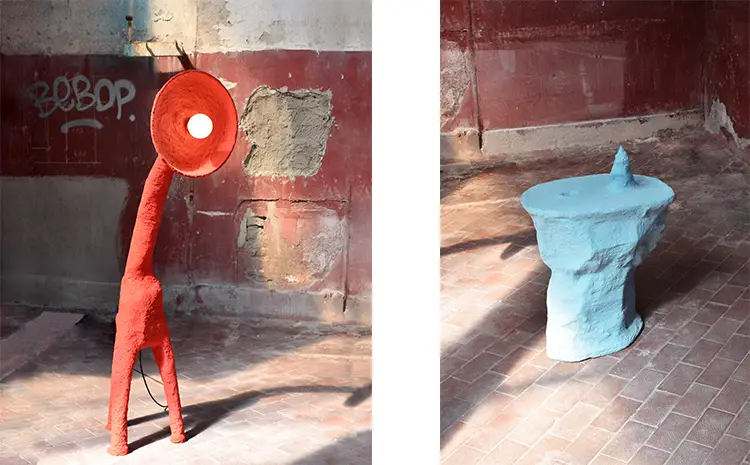
Jonathan Bocca: A Vision Lit from Within
Bocca’s aspiration to reshape the emotional and material landscape of design has recently crystallized in his participation in key exhibitions, including Fuori Salone and Fuego. At Fuego, although his initial proposal for a fireplace was not realized, he presented powerful new works instead, unified by the color red—a hue he associates with memory, urgency, and emotional clarity. One of these pieces, Red Siren, reinterprets his earlier Sirena through the lens of intensity and illumination. With its glowing, disorienting light sources, it blurs the boundary between object and hallucination, inviting viewers to confront both beauty and danger in what attracts them.
At Alcova, his sculptural chair Stelo took center stage—a minimalist yet sturdy structure designed to blur the line between sculpture and seating. Alongside it, he reintroduced Zampa in a more vibrant form for Artemest, painted in bright yellow to amplify its playful, almost creature-like nature. These works build on Bocca’s vision of a new design ecology, one in which objects are not inert but responsive, not decorative but emotionally resonant. They extend his belief that a chair, a lamp, or a table can do more than serve—they can listen, challenge, and inspire.
Looking ahead, Bocca dreams of transforming entire public spaces, beginning with the often-overlooked infrastructure of urban lighting. He envisions lighting not as a cold utility but as a poetic intervention—an opportunity to inject feeling into the daily rhythm of city life. Whether through glowing sirens or conscious sofas, Jonathan Bocca’s work insists that design must be more than functional or fashionable. It must be human, ethical, and alive with emotion. In his hands, recycled paper becomes not waste, but wonder—a second life sculpted into story.
